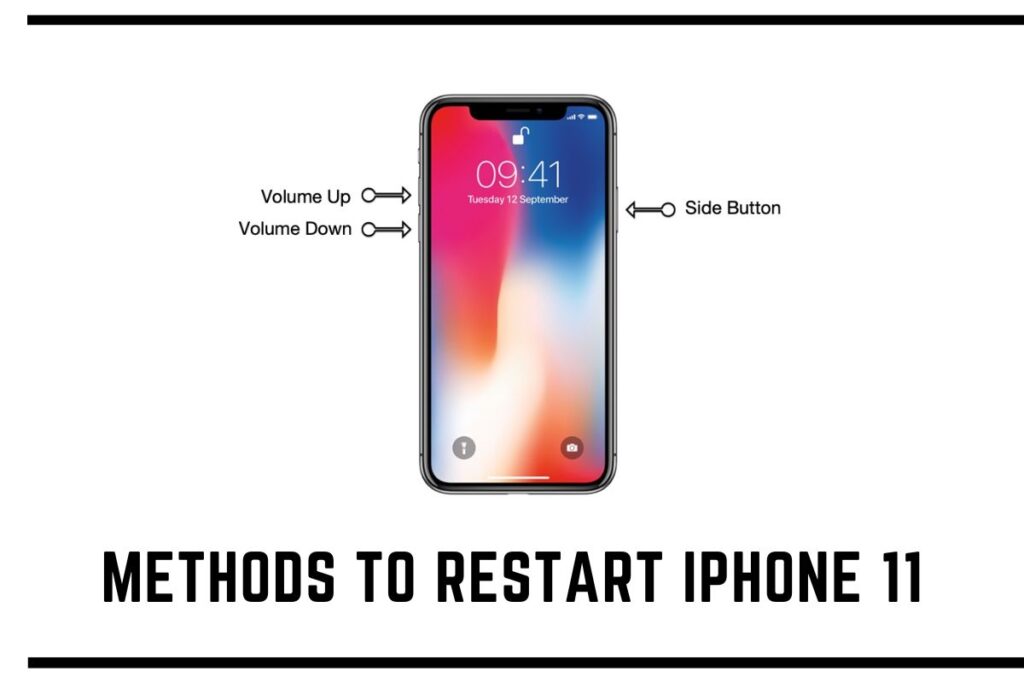When it comes to optimizing the performance of your beloved iPhone 11, knowing how to restart iPhone 11 can be a game-changer. Understanding the nuances of how to restart iPhone 11 is not just about technical prowess; it’s about empowering yourself to manage your device’s performance proactively.
Are you ready to delve into the methods and nuances of a seamless restart iPhone 11 process? Let’s embark on this journey to unravel the secrets of optimizing your iPhone 11’s potential through the power of a restart.
Why Restarting iPhone 11 is Essential?
Restarting your iPhone 11 is essential for maintaining its optimal performance. Regularly rebooting the device helps clear temporary files, refreshes system processes, and resolves minor software glitches. It’s akin to giving your phone a fresh start, ensuring smooth operations, improved battery performance, and overall stability. Embracing the practice of restarting your iPhone 11 empowers you to proactively manage its functionality, ensuring a seamless user experience.
How to Restart iPhone 11?
Restarting your iPhone 11 can be an effective solution when encountering technical glitches or performance issues. Knowing how to restart iPhone 11 properly is essential to maintain its smooth operation. Here’s a step-by-step guide on how to restart iPhone 11 effortlessly:
Step 1: Press and Hold the Side Button
Locate the side button on your iPhone 11. Press and hold either volume button along with the side button until the power-off slider appears on the screen. This action is crucial in initiating the restart of the iPhone 11 process.
Step 2: Slide to Power Off
Once the power-off slider displays, slide it from left to right. This action prompts the device to begin shutting down. It’s the initial phase of the restart iPhone 11 sequence.
Step 3: Turn On Your iPhone 11
After the screen goes completely dark, hold the side button again until the Apple logo appears. Your iPhone 11 will then power back on, completing the restart iPhone 11 process.
By mastering how to restart iPhone 11 effectively, you empower yourself to troubleshoot minor issues and maintain your device’s optimal performance.
Methods to Restart iPhone 11

Knowing different methods to restart iPhone 11 is valuable when faced with various technical scenarios. Whether your device is unresponsive or you simply want to refresh its performance, here are two effective ways to initiate a restart on your iPhone 11:
Method 1: Soft Restart
This method is the standard and most straightforward way to restart iPhone 11:
- Step 1: Press and hold the side button until the power-off slider appears.
- Step 2: Slide the slider, turning off your iPhone 11.
- Step 3: After the device powers down completely, hold the side button again until the Apple logo appears, signifying a successful restart of iPhone 11.
This soft restart is ideal for addressing minor glitches and ensuring your device runs smoothly.
Method 2: Hard Restart
If your iPhone 11 becomes unresponsive or frozen, a hard restart might be necessary:
- Step 1: Quickly press and release the volume up button.
- Step 2: Quickly press and release the volume down button.
- Step 3: Press and hold the side button until the Apple logo appears, indicating the commencement of the restart iPhone 11 process.
This hard restart is a more forceful method, often required when dealing with stubborn issues.
By familiarizing yourself with these two methods to restart iPhone 11, you gain the flexibility to troubleshoot a variety of issues, ensuring your device maintains optimal functionality.
Troubleshooting Common Restart Issues with iPhone 11

Encountering difficulties while attempting to restart iPhone 11 is not uncommon. However, understanding these issues and their solutions can resolve many common hiccups. Let’s explore a few scenarios and troubleshooting tips:
Issue 1: Unresponsive Screen After Restart Attempt
If your iPhone 11 screen remains unresponsive after trying to restart iPhone 11, consider performing a hard restart:
- Hard Restart: Follow the steps for a hard restart outlined previously, as an unresponsive screen might necessitate a more forceful reboot.
Issue 2: Continuous Restart Loop
Sometimes, an iPhone 11 might get stuck in a continuous restart iPhone 11 loop. To address this:
- Step 1: Connect your device to a computer with iTunes.
- Step 2: Launch iTunes and force a restart: quick press volume up, quick press volume down, then hold the side button until the recovery mode screen appears.
- Step 3: Select “Update” or “Restore” on iTunes to resolve the loop issue.
Issue 3: Persistent Software Glitches Post-Restart
After a restart iPhone 11, if persistent software issues persist, consider resetting settings:
- Reset Settings: Go to “Settings” > “General” > “Reset” > “Reset All Settings.” This action won’t erase data but may resolve persistent glitches post-restart.
Issue 4: Inability to Restart
Should your iPhone 11 exhibit an inability to restart iPhone 11 altogether:
- Check Battery: Ensure your device has sufficient charge before attempting a restart. Connect it to a power source if needed.
By troubleshooting these common issues related to restarting the iPhone 11, users can resolve most minor problems and maintain the smooth operation of their device.
Benefits of Regularly Restarting iPhone 11

Regularly restarting your iPhone 11 can offer significant advantages, contributing to its overall performance and functionality. Let’s delve into the benefits of incorporating frequent restarts iPhone 11 into your device routine:
Memory Clearance and System Refresher
Performing periodic restarts iPhone 11 helps clear the device’s temporary memory (RAM) and refreshes the operating system. This action effectively clears out residual processes and apps, allowing the iPhone 11 to run more efficiently.
Software Updates and Bug Resolution
Each restart of the iPhone 11 initiates a check for pending software updates. By regularly restarting, your device can automatically install updates, patching bugs, and enhancing security without user intervention.
Enhanced Battery Performance
Frequent restarts iPhone 11 contribute to better battery performance. It allows the device to recalibrate battery usage, potentially prolonging its lifespan and ensuring optimal performance.
Improved App Functionality
Apps may sometimes encounter glitches or run inefficiently. A periodic restart iPhone 11 closes all apps and clears caches, providing a clean slate for apps to run more smoothly.
Overall Device Stability
Regular restarts iPhone 11 contribute to overall device stability. By giving your device a fresh start, you reduce the likelihood of system crashes or freezes, ensuring a more stable user experience.
Optimization of Background Processes
Background processes can accumulate over time, impacting your device’s performance. Frequent restarts iPhone 11 help clear these processes, ensuring that your device runs optimally.
Incorporating regular restarts iPhone 11 into your device usage routine can significantly contribute to maintaining its efficiency and ensuring a smoother user experience.
Expert Tips for a Seamless Restart of iPhone 11
Experts recommend specific strategies to ensure a smooth restart of the iPhone 11 process, enhancing its effectiveness and maintaining device performance. Let’s explore these expert-recommended tips:
Check Battery Levels
Before initiating a restart of the iPhone 11, ensure your device has sufficient battery. Low battery levels during a restart might cause unexpected shutdowns or incomplete restarts.
Close Background Apps

Manually close all running apps before attempting to restart iPhone 11. This action prevents potential conflicts or disruptions during the restart process, ensuring a smoother reboot.
Perform Routine Software Updates
Regularly update your device’s software. Ensure you’re running the latest iOS version to avoid potential issues that might hinder a successful restart of iPhone 11.
Backup Data

Although a restart generally doesn’t erase data, it’s wise to create a recent backup of your iPhone 11 using iCloud or iTunes. This precaution ensures your data is secure before initiating a restart of the iPhone 11.
Allow Time for Restart
After initiating the restart iPhone 11 process, allow ample time for the device to power off and on completely. Rushing this process might lead to incomplete restarts, causing lingering issues.
Perform Hard Restart When Necessary
In instances of severe software issues or unresponsiveness, consider a hard restart. While not recommended for routine use, a hard restart iPhone 11 can resolve persistent problems.
Seek Professional Assistance if Needed
If your iPhone 11 consistently encounters issues even after multiple restart attempts, consider seeking assistance from an Apple-certified technician. They can diagnose and address underlying problems.
By following these expert tips, you can ensure a smoother and more effective restart iPhone 11 process, maximizing the benefits of device optimization.
Conclusion
In summary, the strategic implementation of a routine restart for iPhone 11 is paramount. Regularly conducting a restart for iPhone 11 ensures optimal functionality, resolving glitches, and refreshing the device’s performance.
Embracing this practice safeguards against potential issues, empowering users to maintain a seamless experience with their iPhone 11. Mastering the art of a timely restart for iPhone 11 is key to sustaining its efficiency and ensuring consistent, hassle-free usage.
FAQs
Can restarting my iPhone 11 delete data?
No, a standard restart iPhone 11 doesn’t delete your data. It merely closes running apps and refreshes the device’s system without impacting stored data.
How often should I restart my iPhone 11?
There isn’t a strict rule, but periodic restarts iPhone 11 are beneficial. It’s suggested to do it whenever your device encounters performance issues or feels sluggish.
Does restarting fix battery-related issues?
A restart iPhone 11 can help recalibrate battery usage but won’t fix underlying battery hardware issues. It might resolve minor battery-related glitches caused by software.
Will restarting affect my installed apps?
Performing a restart iPhone 11 won’t uninstall or modify your installed apps. It merely closes them temporarily and refreshes the device’s operating system.
What if my iPhone 11 doesn’t restart?
If a regular restart of the iPhone 11 doesn’t work, attempt a hard restart by following specific steps. If the issue persists, seek technical assistance or contact Apple Support.
Is there a difference between restarting and resetting?
Yes, a restart iPhone 11 involves turning the device off and on again, while a reset involves erasing data and settings, restoring it to its factory defaults.

